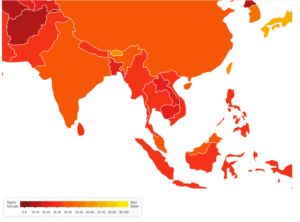Southeast Asia is still among the most corrupt regions in the world and, for the most parts, slowly descending into further corruption, at least according to Transparency International (TI) annual Corruption Perception Index.
Every year the NGO releases a survey in which the countries are ranked according to the level of corruption that TI ranks every year. The higher your score is, the lesser corrupt the country. And it is not looking good for Southeast Asia.
Cambodia is by far the most corrupt country in the region with a score of 21, ranking it 161 out of 176. Myanmar follows suit with a score of 30, ranking it as the 130th least corrupt country. And the rest of the region pretty much stay in this area. Laos is the 135th, Vietnam is ranked at the 107th spot, Thailand is the 96th – all resting in the dark area of the board.
The only beacon in the area is Malaysia, ranking as the 62nd least corrupt country.
Read also: Malaysian Danish Business Council hosted Transparency International
It is difficult to make a general statement on the development in the countries. Some, such as Thailand and Vietnam has improved a bit since 2016 while Cambodia is getting worse according to the index.

The Scandinavian countries are ranking at the very top with Denmark being the second least corrupt country in the world, Norway and Finland being the third and Sweden taking a spot as the sixth least corrupt country and thereby getting the worst ranking in Scandinavia.
The index is based on several parameters. As TI writes in the press release, the countries with “the least protection of journalists and NGO’s tend to have the worst rates of corruption. Every week a journalist is killed in a country that is highly corrupt.”
The study primarily relies on public sources, and needs at least three public and credible sources to include a country in the study.
Further readings can be found on the official webpage, but the methology is also explained in the video below:
